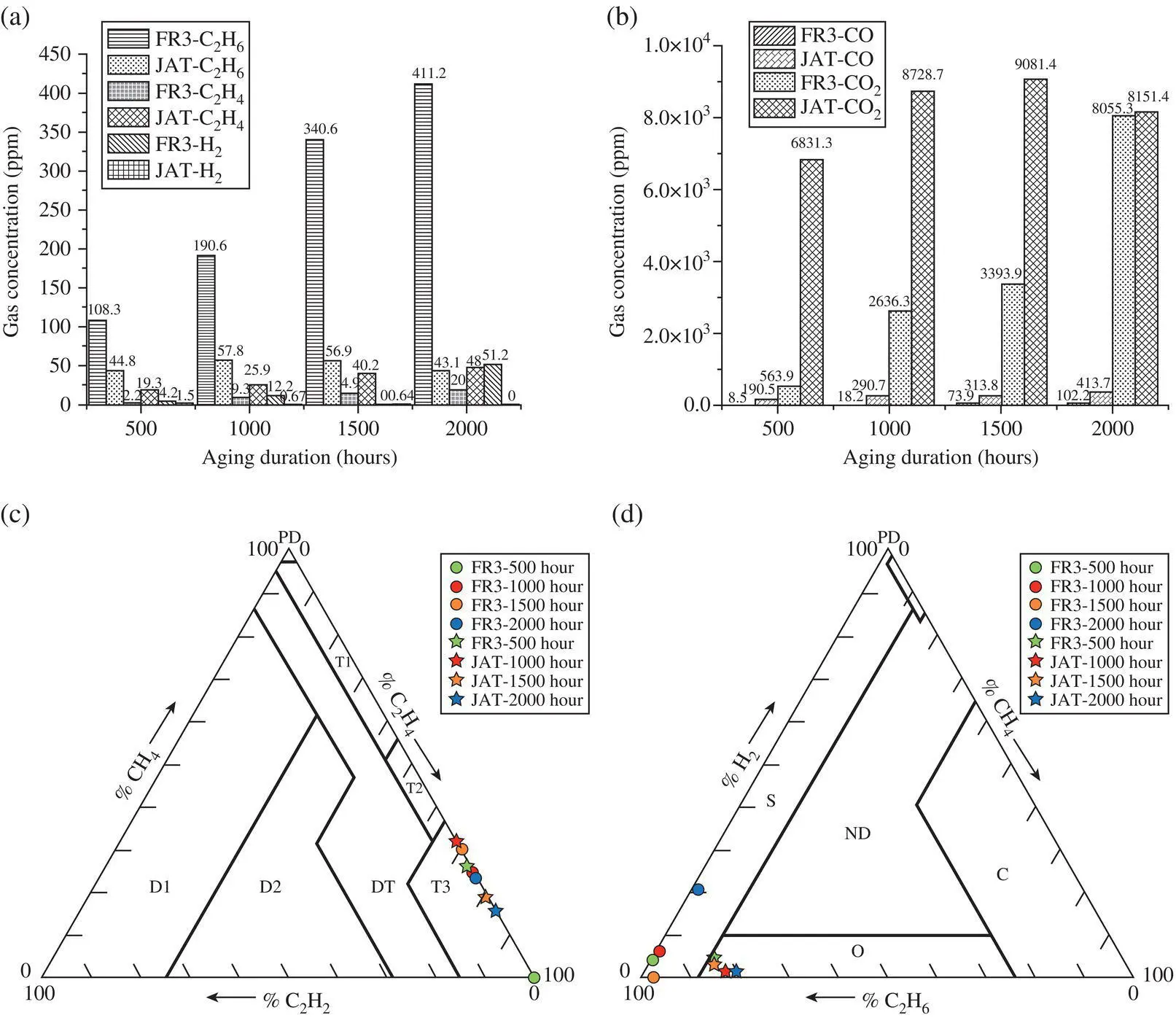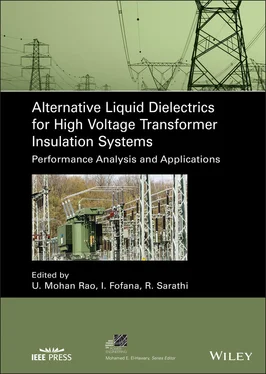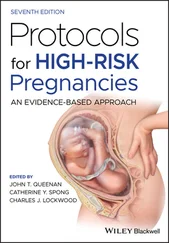The quantity of cases with NEO‐filled transformers is less, so to assess the state of transformer with evolution of the various gases, creating the conditions replicating the inside of the transformer offers fruitful results. The different combinations of gases evolve depending on the temperatures created by the faults. PD is indicated by the formation of H 2and CH 4at low temperatures, whereas arcing faults are indicated by the formation of C 2H 2at high temperatures. When the solid insulation deteriorates and reacts with the insulating oil, the gases like CO and CO 2are formed. A gas chromatograph (GC) is used to measure the extracted gases in the oil. Some studies show the results of DGA of two types of NEOs, namely FR3 and JAT, in Figure 2.12a and b [73]. The total gas content (TGC) is calculated using the formula:
(2.19) 
The H 2production is not very significant in both oils, but it is higher in the case of FR3. The insignificant concentration of H 2gas even after 2000 hours of aging makes the JAT less flammable compared with FR3. A few works show that the higher concentration of C 2H 6may be due to faults at low temperatures below 150 °C. C 2H 4, which is the chief indicator for high‐energy thermal faults, is comparable for both oil types. The presence of solid insulation on reaction with the oil produces CO and CO 2in significant amounts, which indicates cellulose degradation. This happens because paper starts degrading at temperatures above 105 °C and the aging atmosphere influences the deterioration of oil [73]. The gas levels are quite substantial in the case of jatropha oil which might indicate that solid insulation is better safeguarded by FR3. Also, in general, the concentrations of all the gases in this oil increased with the aging duration. The small variations in gas concentrations can be ascribed to the different origination of these oils. The Duval Triangle 3 (recommended for non‐mineral oils) is used for both NEOs, as formulated by Michel Duval. The two NEOs are based on the different compositions of saturated and unsaturated oleic and fatty acids, which result in different patterns of gas generation. In the Duval Triangle 3, CH 4, C 2H 4, and C 2H 2are selected as the sides 3. The fault gas data are replaced into it, and it is observed from Figure 2.12c, that all of the data points for both oil types fall in corresponding thermal faults region. In some circumstances, the data points lie in the boundary regions and it becomes challenging to identify the actual faults. Also, many times stray gases are produced at temperatures below 200 °C in the PD, T1, or T2 zones, and consequently may affect the correct detection of these faults [22]. For analysis purpose of low‐temperature faults, Duval Triangle 6 uses the low‐energy gases (H 2, CH 4, and C 2H 6) as represented in Figure 2.12d. It is seen that stray gassing occurs in FR3 for all aging durations, however, for JAT, overheating is observed.
2.7 Challenges in Using Natural Esters as Insulating Liquid
The challenges faced by natural esters to be used as transformer insulating liquids are mainly in the area of oxidation stability, viscosity, acidity, and pour points. They have higher pour points, lower oxidation stability, higher acidic nature, and high viscosity. Generally, higher viscosity results in lower heat transfer capability. The lower the heat dissipation, the higher is the hotspot temperature. However, some literatures have suggested that having a high specific heat capacity and high thermal conductivity upgrades natural esters to exhibit better cooling performance [68]. The higher hotspot temperature leads to faster degradation of paper and oil. The cost involved in processing the NEO is higher than that of MO; therefore, the final price of NEO is higher than the MO. However, the growing needs for an efficient and eco‐friendly insulating liquid for transformers have been on the rise, so the requirements for the natural esters are increasing. Additives are used for lowering pour points and increasing the oxidation stability; however, these additives lead to the nonuniform electric field in the liquid insulation. The adding of additives also leads to increase in viscosity. The production of natural esters from edible sources will also lead to concern regarding the food economy. The NEO must therefore be processed from the nonedible seeds to avoid the food crisis. The time required for growing nonedible vegetable seeds from the plants is a long process, whereas MO can be quickly extracted from the crude oil.

Figure 2.12 (a) DGA analysis of aged FR3 and JAT – ethane, ethylene, and hydrogen, (b) carbon monoxide and carbon dioxide, (c) Duval Triangle 3 for the aged FR3 and JAT oil samples, and (d) Duval Triangle 6 for the aged FR3 and JAT oil samples.
Source: Baruah et al. [73] / with permission of IEEE.
The chemical structure of natural esters and MOs are not the same, but they comprise analogous bonds, like C–H bonds, so the fault gasses are similar for both the fluids. DGA helps in analyzing the incipient faults in MO, which too can be used for fault detection in natural esters, under thermal and electrical fault conditions. The formation of fault gases takes place when the chemical bonds are broken. The formation of gases in natural esters is greater during PD and lower in arcing, when compared with MO. As the standard for gas formation is mainly concentrated toward MO, it becomes essential to critically analyze the gases generated in natural esters. The key fault gases are significant for interpretation of faults in the transformer. Thus, it is critical to recognize the key gases of natural esters under diverse types of faults so that accurate identification is done. As different types of ester oils come from a variety of seeds and fruits, the content of triglycerides vary in each one of them, and thus the evolution of dissolved gases is different. Therefore, it is imperative to develop and establish a standard method by which dissolved gases can be estimated for all the natural esters effectively.
The solid insulation needs to be impregnated properly with the liquid insulation for enhanced performance by the composite dielectric system. Natural ester‐based fluids have greater viscosities than the conventional MO, which leads to more impregnation time by the ester oil. When the thickness of pressboard is higher, and the insulating oil is a natural ester, it creates a challenge as the viscosity of the liquid is higher and the time taken for impregnation increases accordingly. Laboratory experiments were carried out to study the impregnation process of thicker solid insulation by both NEOs and MO and it was observed that with the rise temperature of the oil, viscosity is reduced and thus decreases the impregnation time. Some studies have ascertained that adequate impregnation of solid insulation with natural esters can be attained at 60 °C within identical time as compared with MO at 20 °C [77].
The design of the transformer or other electrical apparatus, employing MO, also needs to be redesigned to use NEOs as an insulating medium. The design needs to be reviewed and approved and should meet all the requirements to come into the market. The function of the oil is to provide insulation and act as a coolant in the apparatus, and this is regarded as one of the most important areas to be looked into while altering the conventional MO and replacing it with a new fluid. The reaction with the solid insulation, conducting parts, and the thermal losses are to be taken into account while designing the new apparatus. It is desirable to take all these precautions in mind while evaluating the design procedure as the whole insulation system will have an impact on the electrical network, its operation and maintenance, as well as the economic system.
Читать дальше














